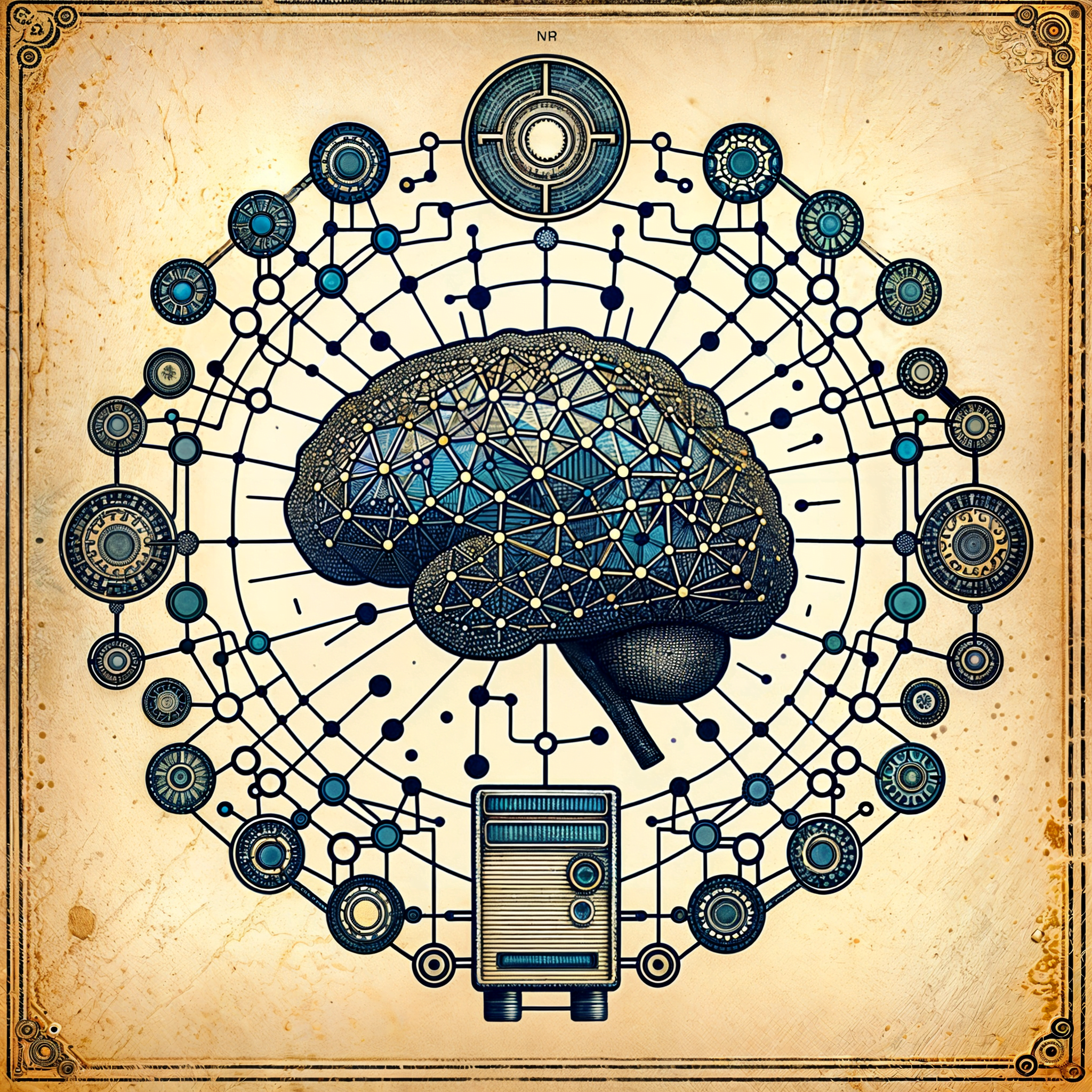Last Updated on February 22, 2024 12:19 pm by Laszlo Szabo / NowadAIs | Published on February 22, 2024 by Laszlo Szabo / NowadAIs
What is Machine Learning? The Beginner’s Guide to Understanding – Key Notes
- Machine Learning is a subset of AI focused on building systems that learn from data.
- It enables computers to make decisions without being explicitly programmed for specific tasks.
- Applications range from voice recognition and recommendation systems to autonomous vehicles.
- Key challenges include data privacy, algorithmic bias, and the need for large datasets.
Introducing “What is Machine Learning?”
The bewildering realm of technology consistently gifts society with transformative tools, and Machine Learning (ML)—a compelling subset of Artificial Intelligence (AI)—is a notably prominent example.
Where traditional programming reaches its limits, ML emerges, equipping computers with algorithms and statistical models that empower them to enhance their performance through acquired experience. By understanding what is Machine Learning, one unlocks a pivotal comprehension of how machines simulate human learning to optimize tasks autonomously. The definition of Machine Learning is pivotal to grasping the underpinnings of modern technology, being integral to systems that extrapolate from ‘what is’ to predict ‘what could be,’ thereby establishing its importance across myriad applications.
Embarking on an exploration of this innovative field, the purpose of this article is focus on the Machine Learning process, answering ‘What is Machine Learning’ and delving into how it operates.
Readers will be equipped with a foundational Machine Learning definition, discern the various machine learning types, and learn about AI machine learning’s practical applications.
As we navigate the complexities of decision trees, artificial neural networks, and deep learning, we also scrutinize the challenges, including overfitting and bias, that arise with machine learning models.
Understanding the distinction between ‘What is Machine Learning vs AI’, or ‘What is Deep Learning vs Machine Learning’, or even ‘What is a Machine Learning Engineer’ will become more tangible.
From data science novices to AI enthusiasts seeking clarity on ‘How does Machine Learning Work’, this beginner’s guide promises a comprehensive foray into the fascinating world of Artificial Intelligence and Machine Learning.
Defining Machine Learning and Types of Machine Learning
Machine learning, a subfield of artificial intelligence (AI), equips computers with the ability to learn from data without being explicitly programmed. This machine learning definition highlights its focus on developing algorithms that enable computers to improve their performance on tasks by analyzing and learning from labeled data.
Historically, the concept of machine learning has been evolving since the mid-20th century when Arthur Samuel coined the term. Over the years, various machine learning types have been developed, such as supervised, unsupervised, and reinforcement learning. Each type serves different purposes and uses different methods to process data and produce results.
The process of machine learning typically involves the following steps:
- Data Collection: Gathering relevant data, which could range from numbers and text to photos, that will be used to train the machine learning model.
- Data Preparation: Organizing and formatting the collected data into a suitable format for training the model.
- Model Selection: Choosing the appropriate machine learning model that is best suited to find patterns or make predictions based on the given data.
- Training: Feeding the prepared data into the model, allowing it to learn and identify patterns or relationships within the data.
- Prediction: Using the trained model to make predictions or decisions when new data is introduced.
Machine learning is not just a theoretical concept but has practical applications that touch many aspects of daily life and business. For instance, machine learning models are integral to recommendation engines, enhancing customer experiences with personalized suggestions. They also play a pivotal role in image and object detection, fraud detection, automated customer service through chatbots, autonomous vehicles, and medical diagnostics, among others.
Looking ahead, the future of machine learning is vibrant with trends like the convergence of blockchain technology and AI, the rise of AI-powered self-service platforms, and the development of personalized AI assistants.
These advancements are set to revolutionize industries, from healthcare with personal medical devices to the automobile industry with smarter vehicles and beyond.
By understanding what is machine learning and its processes, one can appreciate how this technology is not just shaping the future but is also a driving force in creating intelligent systems that enhance human capabilities.
How Machine Learning Works
Understanding how Machine Learning technology works is essential for grasping its impact on computer science and our daily lives.
At its core, Machine Learning is a method by which computers can improve their processing capabilities and decision-making skills from data analysis, without being explicitly programmed for each task.
Here’s a breakdown of the process:
Machine Learning Model and Algorithm Development
- Pattern Recognition: Supervised Machine Learning algorithms are adept at recognizing patterns within large sets of data. By identifying these patterns, the algorithms can make predictions or take actions accordingly. The more data these algorithms are used to process, leading better they become at predicting outcomes, leading to more refined program results.
- Model Selection: The choice of an ML model is crucial, as it determines the algorithm’s ability to learn from data. Different models are suited for different types of tasks, whether it’s recognizing speech, translating languages, or driving autonomous vehicles.
Different Types of Machine Learning
The three primary subcategories of machine learning—supervised, unsupervised, and reinforcement learning—each have unique approaches to data analysis:
- Supervised Learning: In this category, models are trained using labeled datasets. These labels act as answers the machine can use to learn from, allowing it to make more accurate predictions as it processes more data.
- Unsupervised Learning: These models delve into unlabeled data to uncover hidden patterns or trends that are not immediately obvious, providing valuable insights without needing predefined categories or labels.
- Reinforcement Learning: This approach employs a system of rewards and penalties to guide machines in learning through trial and error, promoting actions that lead to the best possible outcomes.
Real-World Data Applications of Machine Learning
Machine Learning thrives in environments rich with data.
The technology is particularly effective when dealing with thousands or even millions of examples, which is common in fields like healthcare, finance, and technology.
Here are some ways machine learning is applied:
- Decision Automation: With vast amounts of data, machine learning can automate decision-making processes in ways that would be impossible for humans, such as real-time fraud detection or traffic management.
- Insight Generation: By processing large datasets, Machine Learning can uncover insights that inform business strategies, scientific research, and technological innovations.
Through these processes, machine learning not only supports but also drives advancements in various industries. By leveraging the power of machine learning, organizations can optimize operations, innovate products, and offer enhanced services, ensuring they remain at the forefront of their respective fields.
In conclusion, Machine Learning is a transformative force in Artificial Intelligence, providing the tools for machines to learn and adapt in ways that mimic human intelligence.
As we continue to generate more data, the capabilities of Machine Learning will only expand, leading to more sophisticated and intuitive applications across all sectors of society. Understanding how machine learning works is the first step towards appreciating its potential and preparing for a future where AI and Machine Learning are integral to our everyday lives.
Machine Learning Applications – the Right Machine Learning

Machine Learning, a cornerstone of Artificial Intelligence, is instrumental in a multitude of applications that streamline and enhance various aspects of our daily lives.
Here are some of the key areas where machine learning has made a significant impact:
Email and Web Security:
- Spam Filters: Email services utilize machine learning to filter out unwanted spam and phishing emails, improving user experience and security.
- Malware Filtering: Web security systems deploy machine learning algorithms to detect and prevent malware infections, safeguarding data and privacy.
Finance and Banking:
- Fraud Detection: Banks and financial institutions leverage machine learning to identify and prevent fraudulent transactions in real time.
- Loan Eligibility: Machine learning models assess credit risk and predict loan eligibility, optimizing the lending process.
Retail and E-commerce:
- Product Recommendations: E-commerce platforms use machine learning to provide personalized product suggestions, increasing sales and customer satisfaction.
- Customer Service: Machine learning powers chatbots and virtual assistants that offer improved customer service by handling inquiries efficiently.
Healthcare:
- Drug Discovery: Machine learning accelerates drug discovery and manufacturing processes, potentially reducing the time to market for new treatments.
- Personalized Medicine: By analyzing patient data, machine learning enables personalized treatment plans, enhancing the effectiveness of healthcare.
Transportation:
- Traffic Prediction: Applications like Google Maps use machine learning to predict traffic conditions and suggest optimal routes.
- Self-driving Cars: Companies like Tesla are at the forefront, integrating machine learning in their autonomous vehicles to improve safety and navigation.
Agriculture:
- Crop Health Monitoring: Machine learning assists in assessing soil erosion levels and monitoring crop health, leading to better yield predictions and farming practices.
- AI Harvesting Bots: These bots help reduce labor costs and improve crop protection, demonstrating the potential of machine learning in agriculture.
Media and Entertainment:
- Content Personalization: Platforms like Netflix gather user activity data to curate personalized content, enhancing the viewer experience.
- Image and Speech Recognition: Social media platforms, such as Facebook, use machine learning for face detection and speech recognition capabilities.
Incorporating machine learning into these applications not only optimizes operational efficiency but also opens up new possibilities for innovation and growth across industries. By harnessing the power of Machine Learning, businesses and services can offer more tailored experiences and solutions, underscoring the transformative nature of this technology.
Machine learning engineers, pivotal in developing these applications, command impressive salaries reflecting the high demand and value of their expertise. As machine learning continues to evolve, its applications are set to become even more integral to our technological landscape, reshaping the way we interact with the world around us.
Trends and Future of Machine Learning Use
As we peer into the near future, the landscape of machine learning is set to undergo transformative changes, impacting economies and industries worldwide.
Here’s a glimpse of the key trends and their potential effects:
Economic Impact:
- By 2030, machine learning is expected to boost the global economy by 14%, which translates to a staggering increase of $15.7 trillion, marking a new era of economic growth driven by AI and ML innovations.
- The machine learning market itself is anticipated to soar to $226 billion by the end of this decade, reflecting the massive amount of data, approximately 2.5 quintillion bytes daily, that businesses generate and analyze through these technologies.
Technological Advancements:
- Explainable AI: This trend focuses on creating transparent machine learning algorithms, which could help build trust, pinpoint biases, and tackle ethical concerns, thereby fostering a more responsible AI ecosystem.
- Federated Learning: By training models on decentralized devices, federated learning upholds privacy, ensuring that sensitive raw data remains secure and unshared.
- AutoML: Automation in Machine Learning democratizes access to AI, enabling more users to create models without extensive technical knowledge, thus broadening the AI talent pool.
- Reinforcement Learning: Machines learning through trial and error, akin to human learning, are set to tackle more complex tasks without the need for explicit supervision.
- Edge Computing: Bringing machine learning closer to the data source dramatically reduces latency, paving the way for real-time analytics and decision-making, crucial for applications like autonomous vehicles and IoT devices.
Software Development and Infrastructure:
- The rise of low-code and no-code platforms will make machine learning more accessible to non-technical business users, allowing them to create ML applications without writing complex code.
- MLOps and DataOps are emerging as key disciplines for managing data and machine learning models, ensuring that applications not only become smarter but also offer a superior customer experience. With the growing demand for skilled professionals, salaries for data scientists and machine learning engineers are on an upward trajectory, highlighting the value of expertise in this field.
- Microservices and containerization are becoming standard for ML infrastructure, enabling scalable, efficient management of machine learning applications and workloads. Future ML models are expected to be more reliable, auditable, and interpretable, addressing current challenges related to biases and errors within ML systems.
As data privacy becomes increasingly critical, consumer expectations and regulations will compel companies to prioritize and enhance their data privacy measures.
By integrating these trends into their strategies, businesses and technologists can harness the full potential of machine learning to innovate and stay competitive in the rapidly evolving digital landscape. Understanding these trends is not just about keeping up with the industry but also about shaping a future where artificial intelligence and machine learning are seamlessly woven into the fabric of everyday life.
Challenges and Ethical Considerations
Understanding what is machine learning involves recognizing not just its capabilities but also the challenges and ethical considerations that accompany its use. These concerns are critical as they directly affect the trustworthiness and societal impact of machine learning systems. Here are some of the key challenges and ethical considerations:
- Bias and Fairness: Machine learning models can inadvertently perpetuate and amplify biases present in training data. This leads to unfair treatment of certain groups and can affect decision-making in critical areas such as employment, law enforcement, and lending.
- Safety and Privacy: As machine learning increasingly handles sensitive data, ensuring the safety of this data against breaches and the privacy of individuals becomes paramount.
- Transparency and Accountability: The ‘black box’ nature of some machine learning algorithms can make it difficult to understand how decisions are made, raising questions about transparency and accountability.
- Human Control: Maintaining human oversight in AI systems is crucial to manage and mitigate risks, especially in scenarios where machine learning models operate autonomously.
- Environmental Impact: The computational power required for training complex machine learning models can have a significant environmental footprint, necessitating sustainable practices in AI development.
- Types of Harm: Machine Learning systems can cause various types of harm, ranging from economic and social to psychological, if not developed and implemented responsibly.To address these issues, the field of AI ethics has emerged, focusing on creating machine learning models that are not only effective but also equitable and safe for all. It encourages the development of AI machine learning systems that are designed with ethical considerations at their core, ensuring they serve the good of society while minimizing potential harms.
Conclusion
As we draw this exploration and guide to Machine Learning to a close, it’s clear that the potential of this technology extends far beyond simple automation.
The foundational understanding provided here not only elucidates what Machine Learning is but also emphasizes its profound impact on numerous sectors, from healthcare to transportation.
It underscores the transformative effects of Machine Learning on our interactions with technology, suggesting a future where data-driven insights become the bedrock of decision-making.
Machine learning stands at the precipice of shaping a world where intelligent systems seamlessly integrate into the very fabric of everyday life. With the ethical considerations and challenges duly acknowledged, the path forward is one of responsible innovation.
As we continue to unlock the vast capabilities of machine learning, it’s vital to ensure that progress in this dynamic field serves to enhance human potential and contribute to the collective benefit of society.
Definitions
- Machine Learning: It’s a field of artificial intelligence that uses statistical techniques to give computers the ability to learn from data, without being explicitly programmed for specific tasks.
- Data Privacy: Refers to the handling, processing, storage, and usage of personal information in a manner that complies with applicable legal and ethical standards.
- Artificial Intelligence (AI): A broad area of computer science aiming to create systems capable of performing tasks that normally require human intelligence, including learning, decision-making, and problem-solving.
- Application: In the context of AI, an application refers to the use of technology to address specific real-world problems or tasks, such as language translation, traffic navigation, or personalized recommendations.
- AI Fraud Detection: The use of machine learning algorithms and AI technologies to detect and prevent fraudulent activities by analyzing patterns in data that may indicate malicious behavior.
- Robotic Process Automation (RPA): A technology for automating repetitive tasks that previously required human intervention, using software robots or AI workers.
Frequently Asked Questions
- What is machine learning and how does it work?
Machine learning is AI’s capability to learn and improve from experience without being explicitly programmed, using algorithms to analyze and learn from data. - Why is machine learning important?
Machine learning drives advancements in sectors like healthcare, finance, and technology by automating complex tasks and uncovering insights from data. - How is machine learning used in everyday life?
From voice assistants and recommendation systems to email filtering and fraud detection, machine learning enhances various aspects of daily life. - What are the types of machine learning?
The main types include supervised learning, unsupervised learning, and reinforcement learning, each with unique applications and methods. - What skills are required to start learning machine learning?
A foundation in mathematics, statistics, and programming, particularly in languages like Python or R, is essential for understanding machine learning concepts. - How does machine learning differ from traditional programming?
Traditional programming involves coding explicit rules, whereas machine learning algorithms learn the rules from data, improving over time. - What challenges does machine learning face?
Challenges include data privacy concerns, algorithmic bias, the need for large and diverse datasets, and the complexity of model interpretation. - How can businesses benefit from machine learning?
Businesses can leverage machine learning for predictive analytics, customer segmentation, process automation, and enhancing decision-making processes. - What future trends are expected in machine learning?
Anticipate advancements in AI ethics, more accessible machine learning tools, integration with IoT devices, and breakthroughs in unsupervised learning. - What are the ethical considerations in machine learning?
Key concerns include ensuring fairness, transparency, data privacy, and avoiding bias in algorithms to prevent discriminatory outcomes.












